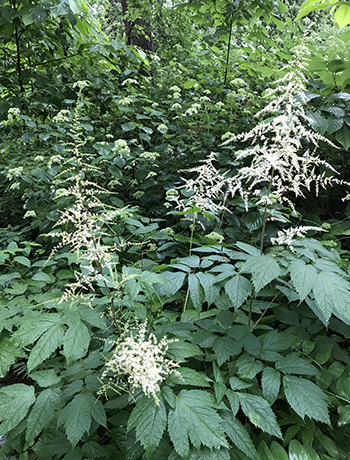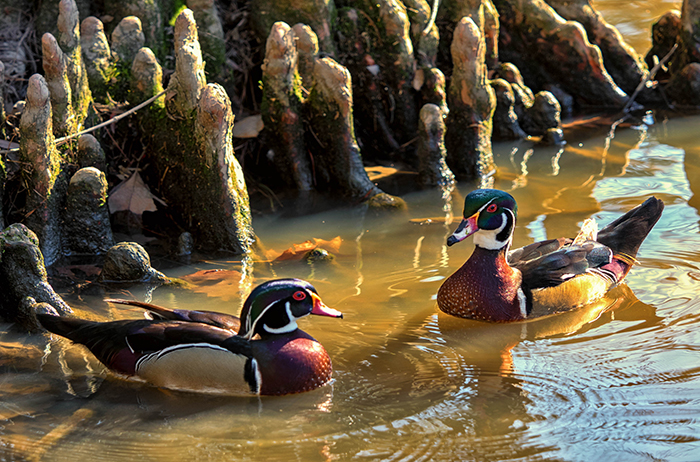Garden Talk

Water, Water, Everywhere
By Katherine Hale

With so much rain engulfing Duke Gardens in recent weeks, it’s been exciting to see which plants have been the most impacted by the dramatic influx of water. All plants need water to survive—but they also need air and light. Each species has adapted to ensure it gets the balance it needs. A series of drenching downpours can tip the balance in unexpected ways as some species celebrate the additional moisture, while others struggle to catch up, and still others can carry on with business as usual.
Aquatic plants already grow in water, so you’d think a little extra moisture wouldn’t bother them. This is true for species that don’t root in soil, like the mosaic plant (Ludwigia sedioides) or water lettuce (Pistia stratiotes), which trap air bubbles in their roots and leaves like living lifejackets to ensure they will always float on the surface, regardless of water levels. However, those rooted in soil and more stationary aquatic species like waterlilies (Nymphaea spp.) and sacred lotus (Nelumbo nucifera)—which grow happily in standing water up to 5 feet deep—have their limits. While they can withstand complete submersion for a time, they will die if the water levels remain too high for too long, depriving them of much-needed light and air.
The same is true for other plants that grow on pond and stream edges, such as the yellow flag iris (Iris pseudoacorus) and soft rush (Juncus effusus). Fortunately, outlets and drains are built into all of Duke Gardens’ water features, ensuring that any excess water will be channeled into the surrounding New Hope Creek watershed to minimize flooding the property.

Oddly enough, cacti and other succulents from desert regions do just fine with brief seasonal increases in watering. In the arid regions they call home, water comes in boom-or-bust cycles, and plants must be ready to grab as much of the bounty as they can when a storm finally hits. Their real nemesis is wet feet –their root systems will not thrive in soggy soil due to lack of oxygen. The solution is to plant them in very well-drained soil-less mixes —special formulations with lightweight volcanic rocks like vermiculite and pumice to keep that all-important air space. With many species able to absorb up to 95% of their volume with water, even 6 to 10 inches of rain isn’t enough to faze them.
Other plants react to high water levels by slowing their growth. This allows species that prefer or tolerate higher moisture levels to get a jump-start on the competition for space and light, rapidly expanding as their competitors shrink in protest. In the Blomquist Garden of Native Plants, curator Annabel Renwick has noticed Appalachian false goatbeard (Astilbe biternata) and the showy white silverleaf hydrangea (Hydrangea radiata) taking off recently with all of the rain. Woodland pinkroot (Spigelia marilandica), a clump-forming native perennial that flourishes in wet soils and light shade, is also especially lush right now.
Only a few species are adaptable enough to handle both deep water and dry spells, and to grow no matter what the weather conditions. One of them is our native bald cypress (Taxodium distichum), which is equally happy growing in upland fields or on the edges of year-round lakes. That said, cypresses growing in frequently flooded soils—like the tree on the edge of the Waterfowl Observation Area in the Culberson Asiatic Arboretum—will develop buttressed trunks with distinctive knobbly “knees,” or woody projections from the roots. Meanwhile cypresses elsewhere in Duke Gardens, like the South Lawn, rarely develop knees. Cypress knees have been a puzzle for centuries, with many scientists believing the knees helped the cypresses to “breathe” more easily during flooding, as is the case with mangroves and other tropical wetland trees. Recent research published in the International Journal of Plant Sciences in 2015 confirmed this to be the case. Cypresses growing in wetlands are likely to be far more tolerant of high-water conditions than their more upland brethren—exemplifying the plasticity within a single species.
Whether too much, too little, or just enough, water plays a critical role in any garden. When the rainy spell ends, it’ll be interesting to see whether the moisture-loving plants will maintain their edge, or if their more drought-tolerant companions will have the advantage as temperatures rise over the summer.

Photos from top: Lush growth on the woodland pinkroot in the Blomquist Garden (Beth Hall Hoffman); scree garden featuring cacti and other succulents in the Terrace Gardens (Bill LeFevre); Appalachian false goatbeard and silverleaf hydrangea in the Blomquist Garden (Annabel Renwick); wood ducks and bald cypress knees in the Culberson Asiatic Arboretum (Joe Rone).





